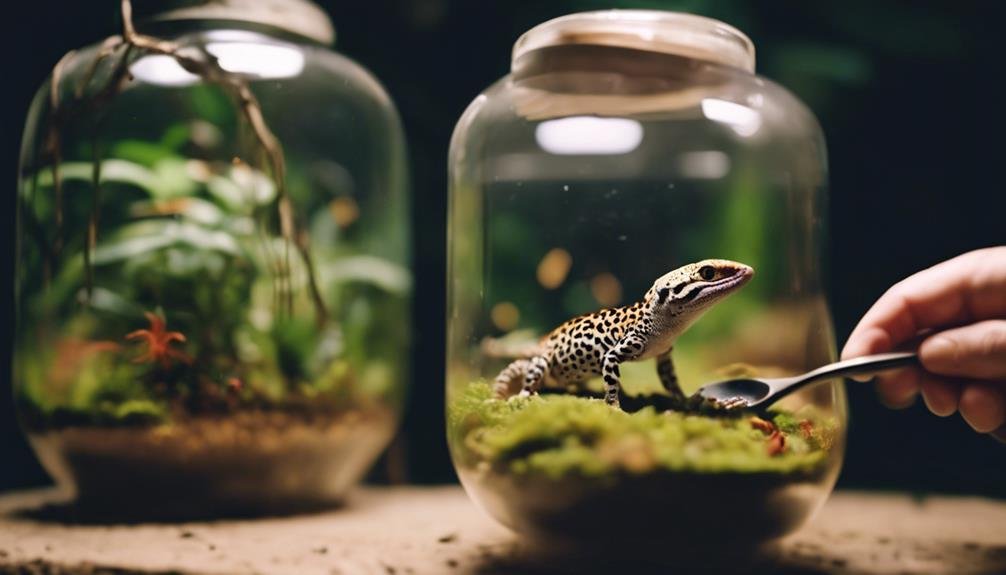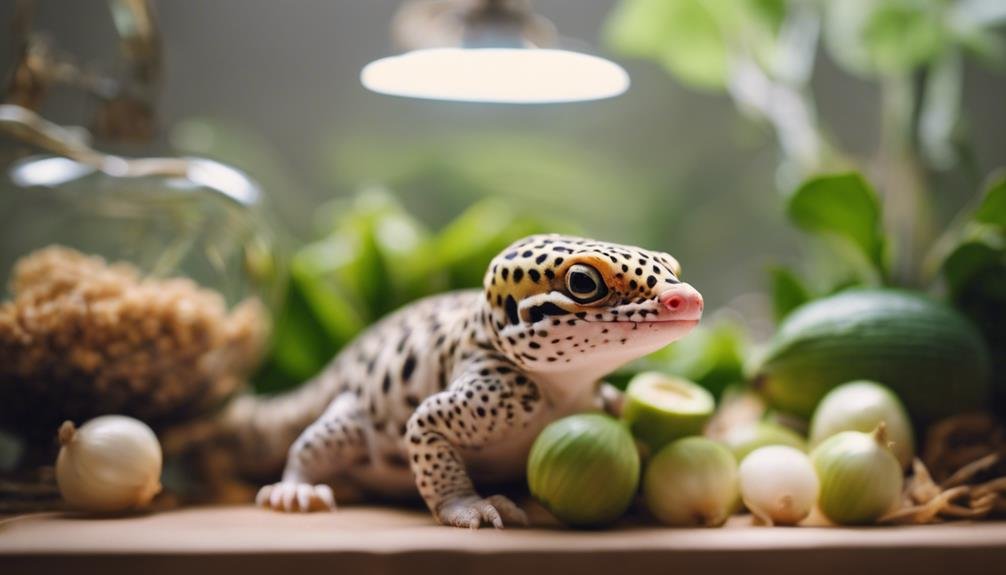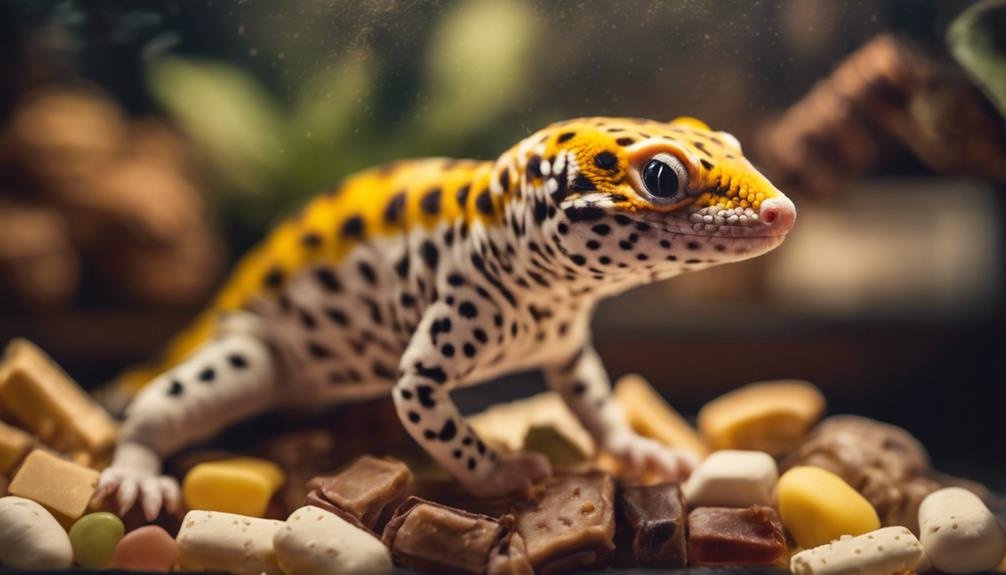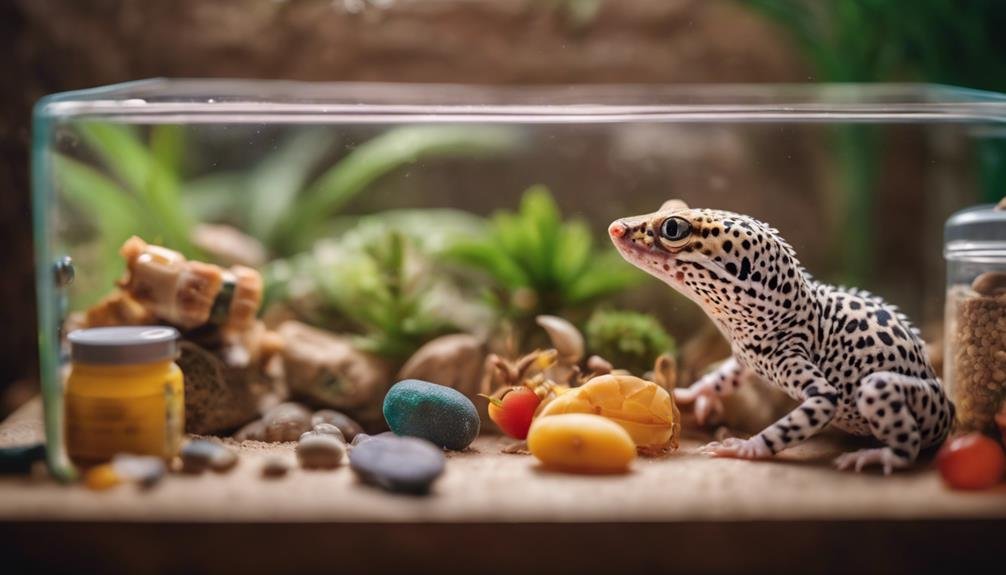Have you ever wondered how often you should feed your leopard gecko to keep it healthy and happy? Whether you’re a seasoned gecko guardian or new to the game, understanding the intricacies of their dietary needs can seem challenging. From the frequency of meals for baby geckos, juveniles, and adults to the ideal size of their prey, there’s a lot to take into account. And let’s not forget the importance of treats and supplements to prevent deficiencies and promote overall well-being. If you’re curious about the best practices for feeding your leopard gecko and how to navigate the array of options, stay tuned for some insightful tips and treats that could transform your approach.
Key Takeaways
- Feed baby geckos daily, juvenile geckos every other day, and adult geckos every 2-3 days.
- Adjust feeding frequency based on the gecko’s appetite, health, and body condition.
- Offer treats like waxworms sparingly and prefer healthier options like butterworms or silkworms.
- Use calcium powder and Vitamin D3 supplements to prevent nutritional deficiencies.
- Monitor gecko’s weight and adjust diet to prevent obesity, ensuring portion control with appropriately sized insects.
Age-Based Feeding Schedule
Understanding how often to feed your leopard gecko is important, and it varies greatly with age. For your baby gecko, under 1 year old, daily feeding is vital to support their rapid growth and high energy needs. This frequent feeding schedule helps them develop properly, but it’s also where you need to be cautious of overfeeding, which can lead to health issues.
As your leopard gecko matures into the juvenile stage, between 1 and 2 years old, you can ease back on the frequency. Feeding them every other day promotes healthy eating habits and guarantees they’re getting the nutrients they need without the risk of overfeeding. It’s a balance between supporting their growth and maintaining a healthy weight.
Once your leopard geckos reach adulthood, over 2 years old, their metabolism slows down. At this stage, feeding every 2-3 days is sufficient to maintain their health and weight. Always adjust the feeding frequency based on your gecko’s appetite, health status, and body condition. Monitoring and adjusting their feeding schedule as they age is key to preventing overfeeding and ensuring their well-being.
Ideal Food Size Guide
Now that you understand the age-based feeding schedule for your leopard gecko, it’s essential to focus on the size of the insects you’re offering.
Matching the prey size to your gecko’s age and size not only prevents choking hazards but also promotes proper digestion and health.
Additionally, incorporating a variety of appropriately sized insects will guarantee your gecko receives a balanced diet.
Prey Size Matching
To ensure your leopard gecko’s safety and health, it’s important to match the size of its prey to the size of its head, avoiding any food items wider than the space between its eyes. When feeding your leopard geckos, choosing the right prey size is essential to prevent choking and digestive issues.
Smaller geckos require smaller insects, ensuring the food can be comfortably consumed and digested. The rule of thumb is that prey should never be wider than the space between your gecko’s eyes. This guideline helps in selecting the appropriate insects, promoting easy swallowing and digestion.
Adhering to these prey size recommendations will greatly contribute to the well-being of your leopard geckos, making feeding times stress-free for both you and your pet.
Insect Variety Importance
Why should you offer your leopard gecko a variety of insects? Well, it’s essential for their health, happiness, and growth. Here’s why mixing up their diet with different insects is important:
- Balanced Diet: An insect variety guarantees Leopard Geckos receive a balanced diet, critical for their development.
- Nutritional Benefits: Different insects provide various nutritional benefits, supporting overall health.
- Feeding Routine: Observing your gecko’s preferences allows you to adjust their feeding routine for better satisfaction and health.
- Hunting Skills: Offering a range of insect sizes caters to your gecko’s age and hunting ability, keeping them engaged and active.
Incorporating a variety of insects into your Leopard Gecko’s diet not only contributes to their nutritional needs but also enriches their day-to-day life.
Daily Feeding Quantities


Determining the right amount of food for your leopard gecko hinges on their age, health, and unique appetite. It’s essential to adjust their daily feeding based on the gecko’s age, their appetite, and body condition. Monitoring these factors will help guarantee your pet maintains a healthy weight and overall well-being.
Here’s a simple guide to help you figure out how much to feed your leopard geckos at different stages of their lives:
| Gecko’s Age | Feeding Frequency | Quantity per Feeding |
|---|---|---|
| Baby (<1 year) | Daily | Up to 10 small insects |
| Juvenile (<1 year) | Daily | Varies; adjust to appetite |
| Adult (>1 year) | A few times a week | 6-8 insects |
| – | Based on health | Adjust as necessary |
| – | Monitor body condition | Adjust to maintain health |
Safe Treats and Supplements
Incorporating safe treats and essential supplements into your leopard gecko’s diet can greatly enhance their health and well-being. While Leopard Geckos eat a variety of insects, adding variety through safe treats and ensuring they receive essential nutrients through supplements are key to a balanced diet.
Here’s a guide to enriching your gecko’s diet:
- Waxworms: Offer these sparingly. Although they’re a favorite, their high fat content means they should be a treat, not a staple.
- Butterworms and Silkworms: These can be included as part of a varied diet. They’re less fatty than waxworms, making them a healthier treat option.
- Calcium Powder: Dusting insects with calcium powder before feeding is important. It ensures your gecko gets enough calcium, preventing health issues related to calcium deficiency.
- Vitamin D3 Supplements: These are essential, especially for geckos that mightn’t be exposed to natural sunlight or adequate UVB lighting. It helps them metabolize calcium properly.
Foods to Avoid


When planning your leopard gecko’s diet, it’s important to know which foods to exclude to avoid health issues. Since geckos are insectivores, you must steer clear of feeding them fruits and vegetables. These items don’t provide the necessary nutrients and can lead to digestive problems.
Also, avoid toxic foods, especially bugs that light up, such as fireflies. These insects contain substances that can be harmful, even fatal, to your gecko.
Moreover, it’s essential not to give your gecko dead or dried insects. These lack the nutritional value of live, gut-loaded insects, which are essential for providing your gecko with the right balance of vitamins and minerals, especially calcium. Remember, always gut load your gecko’s live food 24-48 hours before feeding to ensure they’re nutrient-rich.
While treats like waxworms and superworms might seem like a good idea, limit their intake due to the high fat content, which isn’t ideal for your gecko’s health. Lastly, make sure fresh water is always available for your gecko, but avoid adding vitamin drops to it, as this can disrupt their nutrient balance.
Preventing Obesity
To guarantee your leopard gecko stays healthy, it’s vital to recognize signs of obesity and understand how to adjust their diet accordingly.
You’ll also find that incorporating more activity into their routine can play a significant role in maintaining their weight.
Let’s explore how identifying obesity signs, modifying their diet, and encouraging exercise can prevent health issues.
Identifying Obesity Signs
Monitoring your leopard gecko for signs of obesity, such as visibly bulging fat pads on the head and body, is essential for their health. Obesity can lead to serious health issues, including fatty liver disease and a reduced lifespan.
To prevent obesity in leopard geckos:
- Avoid overfeeding fatty insects like waxworms and superworms.
- Adjust feeding frequency and amount based on your gecko’s age, size, and activity level.
- Regularly assess your gecko’s body condition and weight.
- Be mindful of the signs of obesity, including the visibility of fat pads.
Diet Modification Strategies
Adapting your leopard gecko’s diet is essential for preventing obesity and ensuring their long-term health. Adjusting feeding frequency based on your gecko’s age, size, and health status plays an important role in obesity prevention.
It’s important to monitor their body condition and weight regularly to accurately assess their dietary needs. To avoid unnecessary weight gain, steer clear of overfeeding fatty insects and treats like waxworms.
Implementing portion control by offering appropriately sized insects helps maintain a healthy weight. For tailored diet modification strategies, consulting a veterinarian can provide personalized advice to prevent obesity in leopard geckos.
Exercise and Activity Tips
Besides adjusting their diet, providing your leopard gecko with regular exercise and engaging activities is crucial to preventing obesity. Here are some ways to guarantee your pet stays healthy and active:
- Encourage natural behaviors by designing their habitat with climbing structures and areas to explore, mimicking their natural environment.
- Offer various hiding spots and structures to climb on, promoting physical activity and mental stimulation.
- Avoid overfeeding and consistently monitor your leopard gecko’s body condition to help prevent obesity.
- Engage in interactive play sessions to stimulate both physical movement and mental enrichment, enhancing their overall well-being.
Incorporating these steps won’t only aid in obesity prevention but also ensure your leopard geckos exhibit their natural behaviors through exercise and interactive play.
Hydration Essentials
To guarantee your leopard gecko stays healthy and hydrated, always provide a shallow dish of fresh water in their habitat. This important step is essential for their well-being, as hydration plays a key role in their overall health, digestion, and shedding process. It’s important to change the water daily to maintain cleanliness and prevent any bacterial growth that could harm your pet.
Avoid the temptation to add vitamin drops or supplements to the water dish, as fresh water is what your leopard gecko needs most. Dehydration can quickly become a serious issue for these reptiles, so it’s important to monitor their water intake closely. Look out for signs that they’re not drinking enough, and make sure that the water dish is always accessible and filled with clean water.
Recognizing Feeding Issues


After ensuring your leopard gecko’s hydration needs are met, it’s equally important to recognize signs of feeding issues that could affect their health. Observing your pet’s eating patterns closely will help you identify any problems early on, ensuring they remain healthy and happy. Here’s what you need to look out for:
- Watch for signs of reduced appetite, such as ignoring or refusing food. This might be the first indication that something isn’t right.
- Monitor weight changes and physical appearance regularly. Significant shifts in weight or changes in their appearance can signal feeding issues that need immediate attention.
- Note any stress factors like new environments, excessive handling, or changes in the tank that might be affecting their willingness to eat. Stress can lead to a reduced appetite, impacting their overall health.
- Keep a feeding log to track patterns and identify any consistent issues. If problems persist, consult a vet to rule out any health issues or illnesses.
Gut Loading and Dusting Techniques
Enhancing your leopard gecko’s diet through gut loading and dusting techniques is vital for their nutritional health. Gut loading involves feeding insects nutritious foods for at least 24 hours before you offer them to your gecko. This process ensures the insects are packed with essential nutrients that pass on to your gecko when consumed. It’s important to avoid using vegetable scraps for gut loading, as they may lack the necessary nutrients. Instead, opt for a balanced diet for the insects that includes high-quality commercial gut load products or a variety of fresh fruits and vegetables known to be rich in vitamins and minerals.
Additionally, hydrating insects with gel water crystals during the gut loading process keeps them healthy and nutritious, ready to be a valuable part of your gecko’s diet. Dusting feeder insects with calcium powder right before feeding is another important step. This technique helps prevent metabolic bone disease in leopard geckos, ensuring they receive adequate calcium for bone health. By combining gut loading and dusting, you enhance the nutritional value of every meal, supporting your leopard gecko’s overall well-being.
Can the Feeding Schedule for Leopard Geckos also Apply to Crested Geckos?
Yes, the feeding schedule for Leopard Geckos can be somewhat similar to that of Crested Geckos. However, it’s important to note that Crested Geckos are primarily fruit and insectivores, so their diet may require some modifications. For more information, consider checking out a crestie size guide for specific feeding recommendations.
Frequently Asked Questions
What Are Tips for Feeding Leopard Geckos?
When feeding your leopard gecko, stick to a regular feeding schedule that matches their age and needs. Offer a nutritional variety in their diet, and don’t forget to dust their food with supplements for extra health benefits.
Always provide fresh water, and consider the meal timing to align with their natural hunting habits. Make sure the prey size is appropriate, avoiding anything larger than the space between their eyes to prevent choking.
How Much Should a Leopard Gecko Eat per Day?
You should tailor your leopard gecko’s daily diet based on age considerations, ensuring nutritional balance and a variety of foods.
Baby geckos need up to 10 insects daily, while adults thrive on 6-8 insects a few times a week.
Always provide fresh water and adjust feeding times to maintain health. Monitoring their condition helps strike the right balance, avoiding overfeeding.
How Many Bugs Should a Leopard Gecko Eat per Week?
You’ll want to tailor your leopard gecko’s weekly diet based on age, offering babies up to 70 insects, while adults might need around 20-30, factoring in their size and metabolic needs. Guarantee a variety of insects, appropriate prey size, and hydration.
Incorporate nutritional supplements to support their health. Adjust the feeding schedule as they grow, observing their appetite and physical condition to keep them thriving.
Do Leopard Geckos Like Treats?
Yes, leopard geckos do like treats. Their favorite snacks include waxworms and superworms, which should be given as nutritional supplements rather than main meals due to their high fat content. Feeding frequency for treats should be limited to maintain their health.
While considering their taste preferences, remember to include safe fruits occasionally and always make sure they meet their hydration needs. Moderation is key to keeping your gecko healthy and happy.
Conclusion
Feeding your leopard gecko right is key to their health. Stick to an age-based schedule, match food size to their head, and avoid overfeeding. Incorporate safe treats like butterworms and silkworms sparingly. Don’t forget calcium and Vitamin D3 supplements to prevent deficiencies.
Watch their weight to prevent obesity and make sure they’re well-hydrated. Also, practice gut loading and dusting to boost nutrition. If you notice any feeding issues, adjust their diet or consult a vet. Your gecko’s well-being depends on your care.


